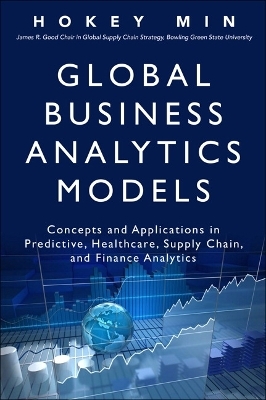
Global Business Analytics Models
Pearson FT Press (Verlag)
978-0-13-405760-6 (ISBN)
- Titel z.Zt. nicht lieferbar
- Versandkostenfrei
- Auch auf Rechnung
- Artikel merken
Practical techniques for developing reliable, actionable intelligence–and using it to craft strategy
Analytical opportunities to solve key managerial problems in global enterprises
Written for working managers: packed with realistic, useful examples
This guide helps global managers use modern analytics to gain reliable, actionable, and timely business intelligence–and use it to manage risk, build winning strategies, and solve urgent problems.
Dr. Hokey Min offers a practical, easy-to-understand overview of business analytics in a global context, focusing especially on managerial and strategic implications. After demystifying today’s core quantitative tools, he demonstrates them at work in a wide spectrum of global applications.
You’ll build models to help segment global markets, forecast demand, assess risk, plan financing, optimize supply chains, and more. Along the way, you’ll find practical guidance for developing analytic thinking, operationalizing Big Data in global environments, and preparing for future analytical innovations.
Whether you’re a global executive, strategist, analyst, marketer, supply chain professional, student or researcher, this book will help you drive real value from analytics–in smarter decisions, improved strategy, and better management .
In today’s global business environments characterized by growing complexity, volatility, and uncertainty, business analytics has become an indispensable tool for managing these challenges. Specifically, global managers need analytics expertise to solve problems, identify opportunities, shape strategy, mitigate risk, and improve their day-to-day operational efficiency.
Now, for the first time, there’s an analytics guide designed specifically for decision-makers in global organizations. Leveraging his experience teaching a number of students and training hundreds of managers and executives, Dr. Hokey Min demystifies the principles and tools of modern business analytics, and demonstrates their real-world use in global business.
First, Dr. Min identifies key success factors and mindsets, helping you establish the preconditions for effective analysis. Next, he walks you through the practicalities of collecting, organizing, and analyzing Big Data, and developing models to transform them into actionable insight.
Building on these foundations, he illustrates core analytical applications in finance, healthcare, and global supply chains. He concludes by previewing emerging trends in analytics, including the newest tools for automated decision-making.
Compare today’s key quantitative tools
Stats, data mining, OR, and simulation: how they work, when to use them
Get the right data...
...and get the data right
Predict the future...
...and sense its arrival sooner than others can
Implement high-value analytics applications...
...in finance, supply chains, healthcare, and beyond
Dr. Hokey Min is James R. Good Chair in Global Supply Chain Strategy in the Department of Management at Bowling Green State University. He was Professor of Supply Chain Management, Distinguished University Scholar, and Founding Executive Director of the Logistics and Distribution Institute (LoDI), the UPS Center for World-Wide Supply Chain Management, and the Center for Supply Chain Workforce Development at the University of Louisville. He earned his Ph.D. degree in Management Sciences and Logistics from the Ohio State University. His expertise includes global logistics strategy, healthcare supply chains, closed-loop supply chains, e-synchronized supply chains, service benchmarking, and supply chain modeling. He has published more than 175 scholarly articles in various refereed journals, including European Journal of Operational Research, Journal of Business Logistics, International Journal of Physical Distribution and Logistics Management, Journal of Supply Chain Management, Supply Chain Management: An International Journal, Journal of the Operational Research Society, International Journal of Production Research, International Journal of Production Economics, Transportation Journal, and Transportation Research. He recently authored two books: one titled Healthcare Supply Chain Management: Basic Concept and Principles, and another titled The Essentials of Supply Chain Management: New Business Concepts and Applications. He has also engaged in numerous consulting projects with more than 50 organizations, including UPS, Brown-Forman Beverage World-Wide, Syntel Inc., Calphalon, Nationwide Insurance, National Tobacco Company, Time-It Transportation, Pegasus Transportation Inc., Usher Transport Inc., Nagle Trucking, Houston-Johnson Inc., Master Halco, Briggs and Stratten, WestPoint Stevens, ScanSteel Inc., Dixie Warehouse Services, GenLyte Thomas Industries, Owens Corning, Buckeye Cable Systems, Andersons Inc., BioFit, Kentucky Motor Transport Association, Korea Maritime Institute (KMI), Korea Ocean Research Development Institute (KORDI), the Korea Research Institute of Ships & Ocean Engineering (KRISO), and the Chinese Rural Energy & Environment Agency.
Chapter 1: Introduction to Business Analytics 1
1.1 The Origin and Evolution of Business Analytics 1
1.2 Developing Analytical Thinking 4
1.3 Operationalizing Big Data from Global Perspectives 6
1.4 Extracting Useful Information from Big Data 9
1.5 Unique Challenges for Business Analytics 13
1.6 Capitalizing on Business Analytics for Building a Winning Global Strategy 15
Chapter 2: Collecting, Sorting, Prioritizing, and Storing Big Data 21
2.1 Finding and Capturing the Right Data 21
2.2 Data Sampling 23
2.3 Data Preparation 25
2.4 Data Segmentation 27
2.5 Data Filtering 29
2.6 Data Warehousing 31
2.7 Data Security 35
2.8 Fitting Analytics Models to Data 37
Chapter 3: Business Analytics Models 43
3.1 Quantitative Tools for Business Analytics 43
3.2 Basic Statistical Techniques 45
3.3 R Programming 48
3.4 Hypothesis Testing 49
3.4.1 t-Test 50
3.4.2 ANOVA Test 52
3.4.3 Nonparametric Test 52
3.5 Power Analysis 54
3.6 Data Mining 55
3.6.1 Decision Trees 56
3.6.2 Neural Networks 57
3.6.3 Text Mining 60
3.6.4 Image Mining 62
Chapter 4: Predictive Analytics 67
4.1 Predicting International Customer Behavior 67
4.2 Demand Forecasting in Unfamiliar Foreign Markets 68
4.2.1 Moving Average 69
4.2.2 Exponential Smoothing 70
4.2.3 Trend Analysis 72
4.2.4 Focus Forecasting 73
4.2.5 Agent-Based Forecasting 75
4.3 Global Market Basket Analysis 76
4.4 Risk Analytics 79
4.5 Digital Analytics 81
4.6 Social Sensing 83
4.7 Mobile Analytics 85
Chapter 5: Essentials for the Successful Implementation of Business Analytics 93
5.1 Understanding the Voice of Overseas Customers 93
5.2 Collaborating with Foreign Business Partners for Sharing Big Data 95
5.2.1 Building Trust 96
5.2.2 Establishing an Information Exchange Mechanism 96
5.2.3 Ensuring Secure Data Transmission 97
5.3 Analytics Execution and Implementation 98
5.4 Performance Measurement and Metrics 100
5.5 Outcome Analysis 102
5.6 Corrective Actions 103
5.7 Emulating Best-in-Class Practices 105
Chapter 6: Global Finance Analytics 109
6.1 Foreign Market Scenario Planning 109
6.2 Financing Global Business Operations through Capital Management 111
6.3 Global Financial Risk Assessment 113
6.3.1 Foreign Direct Investment Risk Analysis 114
6.3.2 Loan and Credit Risk Assessment 116
6.3.3 Liquidity Risk Assessment 117
6.3.4 Foreign Currency Exchange Risk Assessment 118
6.3.5 Value at Risk (VaR) as the Financial Risk Measure 121
6.4 Foreign Investment Portfolio Analysis 124
6.5 Product/Service Pricing Using Analytics 126
6.6 Multinational Profit Planning and Budgeting Using Analytics 128
Chapter 7: Global Supply Chain Analytics 135
7.1 Turning Integrated Big Data into Supply Chain Intelligence 135
7.2 Global Sales and Promotion Analytics 137
7.3 Global Sourcing Analytics 140
7.4 Contract Manufacturing Analytics 142
7.5 Distribution Analytics 145
7.6 Transportation Analytics 147
7.7 Integrating Functional Analytics into Global Supply Chain Management 151
Chapter 8: Healthcare Analytics 159
8.1 Healthcare Analytics as an Emerging Discipline 159
8.2 Big Data in Healthcare 161
8.3 Analyzing Clinical and Pharmaceutical Data 164
8.4 Analyzing the Voice of the Patient 167
8.5 Healthcare Quality Function Deployment via Analytics 169
8.6 Healthcare Outcome Analysis 171
Chapter 9: Future of Business Analytics 177
9.1 Innovating Analytics 177
9.2 Embedding Business Analytics into Enterprise-wide Information Systems 180
9.3 Future Roles of Business Analytics in Global Business Intelligence 181
9.4 Epilogue 183
Index 187
| Erscheint lt. Verlag | 25.4.2016 |
|---|---|
| Reihe/Serie | FT Press Analytics |
| Verlagsort | NJ |
| Sprache | englisch |
| Maße | 164 x 229 mm |
| Gewicht | 416 g |
| Themenwelt | Mathematik / Informatik ► Informatik ► Datenbanken |
| Informatik ► Office Programme ► Outlook | |
| Technik | |
| Wirtschaft ► Betriebswirtschaft / Management ► Logistik / Produktion | |
| Wirtschaft ► Betriebswirtschaft / Management ► Unternehmensführung / Management | |
| ISBN-10 | 0-13-405760-0 / 0134057600 |
| ISBN-13 | 978-0-13-405760-6 / 9780134057606 |
| Zustand | Neuware |
| Haben Sie eine Frage zum Produkt? |
aus dem Bereich


